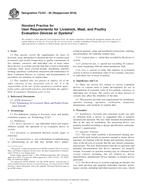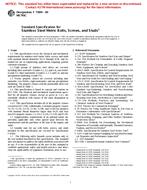1.1 These test methods cover the determination of cyanides in water. The following test methods are included:
| Sections | |
| Test Method A–Total Cyanides after Distillation | 12 to 18 |
| Test Method B–Cyanides Amenable to Chlorination by Difference | 19 to 25 |
| Test Method C–Weak Acid Dissociable Cyanides | 26 to 32 |
| Test Method D–Cyanides Amenable to Chlorination without Distillation (Short-Cut Method) | 33 to 39 |
1.2 Cyanogen halides may be determined separately.
Note 1 – Cyanogen chloride is the most common of the cyanogen halide complexes as it is a reaction product and is usually present when chlorinating cyanide-containing industrial waste water. For the presence or absence of CNCl, the spot test method given in Annex A1 can be used.
1.3 These test methods do not distinguish between cyanide ions and metallocyanide compounds and complexes. Furthermore, they do not detect the cyanates. Cyanates can be determined using ion chromatography without digestion.
Note 2 – The cyanate complexes are decomposed when the sample is acidified in the distillation procedure.
1.4 The cyanide in cyanocomplexes of gold, platinum, cobalt and some other transition metals is not completely recovered by these test methods. Refer to Test Method D6994 for the determination of cyanometal complexes.
1.5 Cyanide from only a few organic cyanides are recovered, and those only to a minor extent.
1.6 Part or all of these test methods have been used successfully with reagent water and various waste waters. It is the user’s responsibility to assure the validity of the test method for the water matrix being tested.
1.7 This standard does not purport to address all of the safety concerns, if any, associated with its use. It is the responsibility of the user of this standard to establish appropriate safety and health practices and determine the applicability of regulatory limitations prior to use. Specific hazard statements are given in sections 5.1, 8.8, 8.18, 9, 11.3, and 16.1.9.
12.1 This test method covers the determination of cyanides in water, including the iron cyanide complexes (total cyanide).
12.2 The cyanide in some cyano complexes of transition metals, for example, cobalt, gold, platinum, etc., is not determined.
12.3 The cyanide concentration can be determined with titration, IC-PAD, colorimetric, selective ion electrode procedure, or flow injection analysis with gas diffusion separation and amperometric detection as described in Test Method D6888.
12.4 This test method has been used successfully on reagent and surface water and coke plant, refinery, and sanitary waste waters. It is the user’s responsibility to assure the validity of the test method for the water matrix being tested.
12.5 Because of the sample preservation, certain suspended and/or colloidal forms of metal cyanide complexes such as those from iron and copper will dissolve prior to the distillation step. The recovery of this cyanide may depend on solution parameters such as the cyanide concentration in suspended solids, ionic strength of the sample, sample temperature, acid digestion times, and so forth.
19.1 This test method covers the determination of cyanides amenable to chlorination in water.
19.2 Iron cyanides are the most commonly encountered compounds not amenable to chlorination.
19.3 This test method has been used on reagent, surface, and industrial waste waters. It is the user’s responsibility to assure the validity of the test method for the water matrix being tested.
26.1 This test method covers the determination of cyanide compounds and weak acid dissociable complexes in water.
26.2 The thiocyanate content of a sample usually does not cause interference.
26.3 Any of the three procedures, titration, colorimetric, or selective ion electrode, can be used to determine the cyanide content of the absorption solution. The lower limits of detectability are the same as for Test Method A.
26.4 This test method has been used successfully on reagent and surface water and coke plant, refinery and sanitary waste waters. It is the user’s responsibility to assure the validity of the test method for the water matrix being tested.
33.1 This test method covers the determination of free CN− and CN− complexes that are amenable to chlorination in water. The procedure does not measure cyanates nor iron cyanide complexes. It does, however, determine cyanogen chloride and thiocyanate.
33.2 Modification is outlined for its use in the presence of thiocyanate.
Product Details
- Published:
- 10/01/2009
- Number of Pages:
- 20
- File Size:
- 1 file , 290 KB
- Redline File Size:
- 2 files , 510 KB


